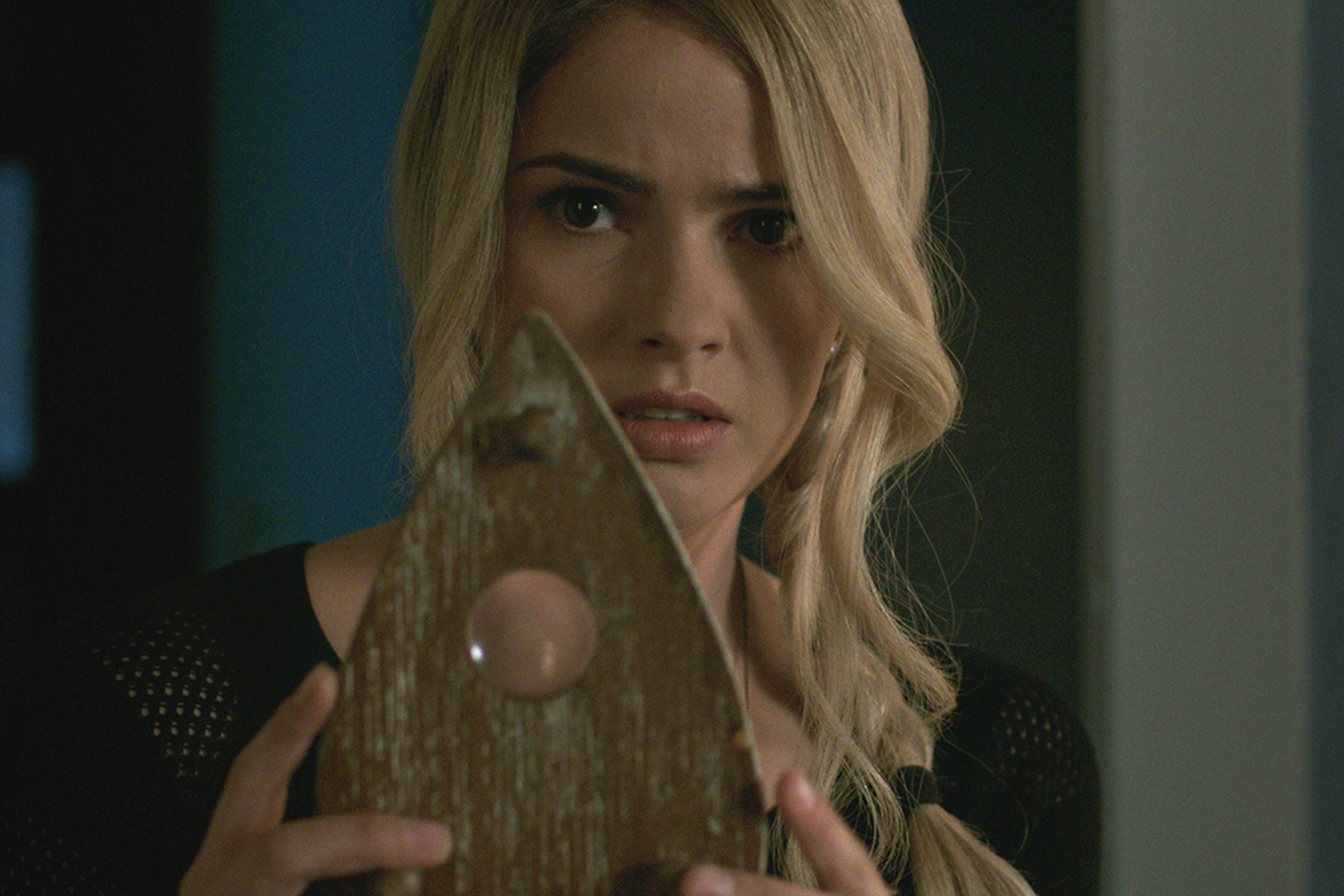
This article contains spoilers. Click here to reveal them.
“Hi friend.” The message spelled out on the letters of a Ouija board sends a chill of hope through five teenagers seated at the dining room table. They have sought some sign from their late friend, who recently hanged herself in this very house. It must be Debbie! But over the next few days, the same phrase materializes menacingly as a computer message, or scrawled on a tunnel wall, or carved into a desk, or finger-painted on a misty car window. So the players return to the house and to the Ouija board. The overhead lights are suddenly doused; an empty chair at the table moves out to make room for some invisible force. “Are you Debbie?” they ask, and the planchette moves to “No.” “Who are you?” You don’t want to know. Let’s just say, Not a friend.
“It’s only a game,” says one skeptic at the table, and she’s right. The Ouija board, once and still used as a seance tool for communicating with the beyond, is marketed by Hasbro for plucky or morbid kids. Even nonbelievers can enjoy frightening themselves and others as they spell out words by moving the planchette from one letter to another. As the little girl in Emily Flake’s famed New Yorker cartoon explains, “It’s like texting, but for dead people.”
Hollywood hopes that Ouija, directed by Stiles White and written by White and Juliet Snowden, will get its message across to audiences: that it’s again O.K. to see a horror movie the week before Halloween. Last year was the first October in a decade that a film chiller — that is, a picture with Saw or Paranormal Activity in its title — did not earn at least $30 million its opening weekend. And in the first nine months of this year, no flat-out horror film came within a scare’s breadth of being a hit.
This October looks more dreadful, by which we mean rosier for the horror movie business. Annabelle, made for just $6.5 million, opened early this month to $37.1 million and in three weeks has taken in $75 million, plus another $90 million in foreign markets. Industry savants predict that Ouija will be No. 1 this weekend — a nice relaxing diversion for Americans ready to flee their TVs, having been terrified by much of the news and social media that Isis or Ebola will kill them. Ouija might simply give them a smart case of the shakes, with a seasonal afterchill.
When teenage Debbie (Shelley Hennig) hangs herself after consulting a Ouija board, her lifelong b.f. Laine (Olivia Cooke, who played the possessed girl in this April’s The Quiet Ones) thinks she can use the board to connect with the dead girl. Debbie’s family has conveniently vacated the premises, leaving Laine to keep an eye on things, from this world and the next. The “Hi friend” message seems to have been sent not by Debbie but by some other restless spirit — perhaps a child murdered by her mother in the same house. Anyway, someone, or some thing, is killing off Laine’s seance friends in generically gruesome fashion…
…and in one innovative way. Isabelle (Bianca Santos, the Angelina Jolie clone from ABC Family’s The Fosters) is in her bathroom, drawing the tub water and flossing her teeth. She turns to the mirror and is startled to see that her mouth has been sewn shut by the floss. As the tub water overflows, some power lifts her body a few feet in the air, then smashes her skull against the porcelain sink. (Moral for impressionable kids: Don’t floss.)
Like Annabelle, Ouija is an old-fashioned horror movie that dabbles in many familiar scare tactics: doors mysteriously creaking open or slamming shut, chandeliers swaying, stove burners spontaneously igniting, dolls that may have a malevolent life of their own, dark secrets lurking in a Psycho-inspired cellar. Ouija also honors the convention of characters whose IQs dip ominously as their peril increases. In a dark house, why don’t the kids think to turn on the lights, or to employ the buddy system when entering a room where evil lurks? Because they’re in a horror movie!
Laine at least has a reason for not throwing out the killer board: she’s ready to risk her life to help Debbie achieve a more restful afterlife. Ouija has a steady directorial hand, some attractive young actors who taking the silliness seriously and few admirable genre elements. It renounces the faux-found-footage ShakyCam style, instead employing a traditionally smooth visual style. It prizes suspense over shock, realizing that waiting for The Thing is harder on a moviegoer’s nerve than seeing The Thing. It’s not about a chainsaw-wielding sado-master; it’s a ghost story, a campfire tale for scaredy cats, a tale of the dead reaching out to touch the living.
And in the month of the Ebola scare, hypochondriacs needn’t worry that someone on the screen will sneeze and infect them. They can go home as healthy as when they arrived, and secure in the knowledge that Ouija, like its Hasbro source toy, is only a game.
More Must-Reads from TIME
- Cybersecurity Experts Are Sounding the Alarm on DOGE
- Meet the 2025 Women of the Year
- The Harsh Truth About Disability Inclusion
- Why Do More Young Adults Have Cancer?
- Colman Domingo Leads With Radical Love
- How to Get Better at Doing Things Alone
- Michelle Zauner Stares Down the Darkness
Contact us at letters@time.com